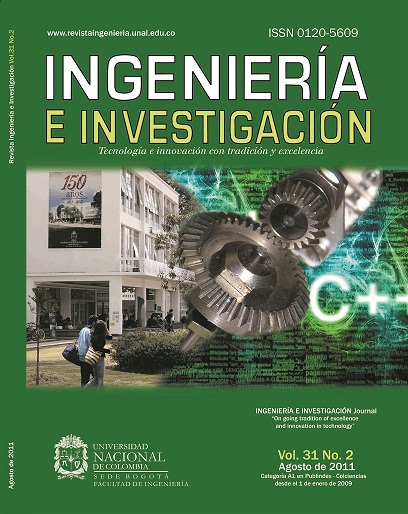Embankment loading analysis in laboratory conditions
Terraplén análisis de carga bajo condiciones de laboratorio
DOI:
https://doi.org/10.15446/ing.investig.v31n2.23602Keywords:
Embankment, modelling, stability, shaking table, nonlinear liquefaction. (en)Embankment, modelling, stability, shaking table, nonlinear liquefaction (es)
The embankment model has been developed in laboratory conditions, considering actual embankment characteristics. The forces to which it is subjected in the model have been evaluated using shaking table experimental and analytical methods. Excess pore water pressure is measured through pore pressure sensors in the shaking table experiment and embankment stability has been assessed using analytical methods. The results revealed that the embankment suffered nonlinear collapse during increasing pore water pressure, and shaking table dynamic force on the embankment model was very sensitive but was open to failure mitigation. Embankment seismic simulation using shaking table experiments helped identify model stability. The embankment and subsoil pore water pressure theoretical and experimental analysis concluded that nonlinear liquefaction characteristics played a major role in model behaviour.
Embankment loading analysis in laboratory conditions
Terraplén análisis de carga bajo condiciones de laboratorio
Abdoullah Namdar1, Azam Khodashenas Pelko2
1 Civil Engineering, Islamic Azad University of Jolfa International Branch, Iran. Faculty of Civil Engineering & Earth Resources, University Malaysia Pahang, Malaysia. ab_namdar@yahoo.com.
2 Civil Engineering, Islamic Azad University of Jolfa International Branch, Iran. Mysore University, Mysore, India. sina_a_n@yahoo.com
ABSTRACT
The embankment model has been developed in laboratory conditions, considering actual embankment characteristics. The forces to which it is subjected in the model have been evaluated using shaking table experimental and analytical methods. Excess pore water pressure is measured through pore pressure sensors in the shaking table experiment and embankment stability has been assessed using analytical methods. The results revealed that the embankment suffered nonlinear collapse during increasing pore water pressure, and shaking table dynamic force on the embankment model was very sensitive but was open to failure mitigation. Embankment seismic simulation using shaking table experiments helped identify model stability. The embankment and subsoil pore water pressure theoretical and experimental analysis concluded that nonlinear liquefaction characteristics played a major role in model behaviour.
Keywords: Embankment, modelling, stability, shaking table, nonlinear liquefaction.
Received: May 25th 2010
Accepted: June 23th 2011
Introduction
Earthquakes are the most catastrophic natural phenomena which cannot be predicted. They are characterised by shaking of the ground in all possible directions, causing hazards of varying intensity to mankind throughout the entire world. However, the effect of earthquakes can be controlled and minimised through some understanding and findings.
Some observations for simulating seismic loading have been made to date (Van Laak et al, 1994; Kanatani et al., 1995; Jafarzadeh and Yanagisawa, 1995; Yoshida and Finn, 2000). Pore water pressure increases in a saturated sand deposit when it is subject to seismic loading and settlement occurs during and after an earthquake due to rearrangement of grains and redistribution of voids within soils. Large settlements can occur, especially when there is liquefaction in the sand deposit. Because of their excessive damaging effect for foundations, utilities and lifelines (Hwang et al., 2003), a method has been proposed for evaluating sand deposit settlement according to the factor of safety against liquefaction (when maximum shear strain reaches 3.5%), relative density (Dr) and maximum induced cyclic shear strain. Although some field observations have been used for comparisons, all developments have mainly been based on the results of laboratory experiments regarding small sand specimens in conditions quite different to those concerning in situ soil deposits in the field. These experiments cannot truly simulate actual sand deposits’ behaviour, especially when there is liquefaction (Ishihara and Yoshimine, 1992). Many researchers’ investigations have reported using shaking table tests, such as analysing radial and rotational shear strain components by using multi-directional horizontal shaking (Chang, 2011). Sand specimen settlement has been measured and evaluated during and after each shaking test (Ueng, et al., 2010). The numerical simulation of three full-scale geosynthetic-reinforced soil walls seismically loaded onto a shaking table have been studied (Lee et al., 2010). Shaking table tests have been used for four full-scale single-story structures to investigate the out-of-plane behaviour of unreinforced masonry (URM) panels in RC frames (Tu et al., 2010). Shaking table tests have been used for scaled utility tunnel models, with and without construction joints, in non-uniform input earthquake wave excitation (Chen et al., 2010). Gradational characteristics regarding reliquefaction mechanisms using 1 g shaking table tests and five sands having differing gradation characteristics have been determined (Ha et al., 2011). The Hilbert-Huang transform dataprocessing technique has been used for characterising the seismic responses of soilâquay wall systems for measuring data in a series of geotechnical centrifuge shaking-table tests (Wei et al., 2010). Many other investigations have been designed for obtaining a better understanding, classification and prediction of all types of liquefaction behaviour (Heidari and Andrus, 2010; Chang et al., 2011; Samui et al., 2011; Shahir y Pak, 2010; Lee et al., 2010; Wang et al., 2011). This paper deals with understanding pore water pressure behaviour by changing soil foundation density in different layers when a dynamic seismic force was applied to a shaking table model, and using an analytical method for understanding embankment dynamic behaviour.
Methodology and experiments
The experimental procedure followed the steps given below:
- Filter plates were fixed and sealed on top of baffle walls inside an acrylic box on the shaking table;
- The aluminium channels were fixed with gummed tape inside the shaking table’s acrylic box;
- The pore pressure sensors (Figure 1) were kept and tied to the string at required location inside the shaking table’s acrylic box;
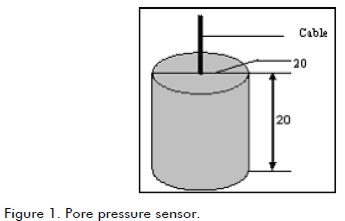
- Signal conditioners for pore pressure sensors were switched on;
- The prepared sand was laid for constructing the model;
- Coloured sand was laid horizontally and vertically every 10 cm;
- Water was slowly allowed through baffle walls for saturating the model;
- Pore pressure sensor readings were set to zero in the corresponding signal conditioner to ascertain excess pore water pressure generated during shaking;
- Shaking was carried out uniformly for a specified duration (~ 12 seconds); and
- The results recorded in a computer were saved soon after completion of the experiment (Namdar, 2009).
An embankment experimental model was considered and Figure 2 gives a schematic diagram of the shaking table with a model embankment whilst Figure 3 gives a ground level cross-section with sand, water level and pore pressure sensor positions for the embankment model.
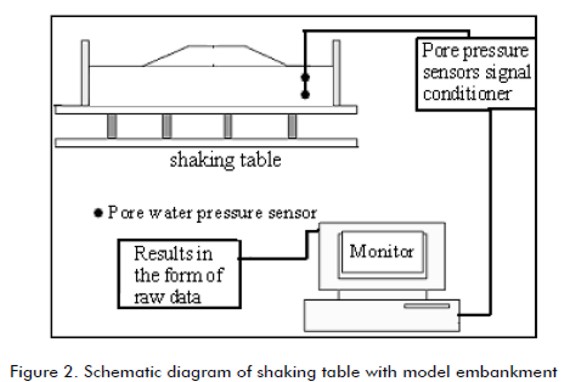

Results and discussion
Shaking table experimental and analytical methods have been used in this practical and theoretical research work for embankment model stability analysis. Tables 1 -2 and Figures 4 -6 give the shaking table test results and analytical calculation results are given in Table 3. The shaking table dynamic force quickly collapsed the system; it was difficult to clearly observe slope failure shape. The pore pressure sensors helped to recognise nonlinear liquefaction.
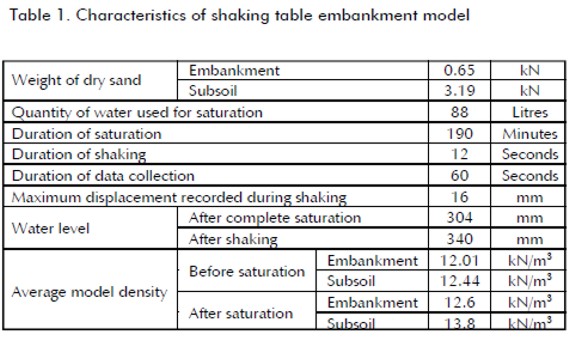

The analytical methods used for calculating safety factor involved three methods: Bishop, ordinary and Janbu in constant mass and volume (Table 3). These results indicated that minimum and maximum safety factors appeared in ordinary and Bishop methods, respectively.
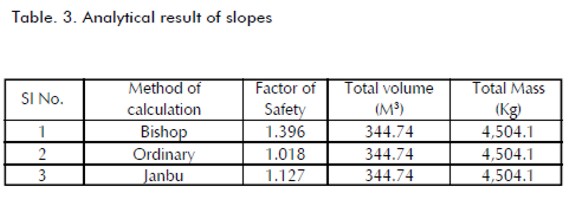
Figures 4 -6 indicate that pore water pressure variation at different parts of the system led to creating nonlinear stress-strain and nonlinear liquefaction. Unit weight in each part of model had to be considered. Figure 6 shows nonlinear liquefied sand approximate tolerance which has direct correlation with the model’s safety and stability factors. The indirect simulation technique clearly indicated that stress-strain, deformation and site stability could be precisely modelled and earth structures could be designed or redesigned based on that for optimising safety factors and maximum stability and minimum project cost.
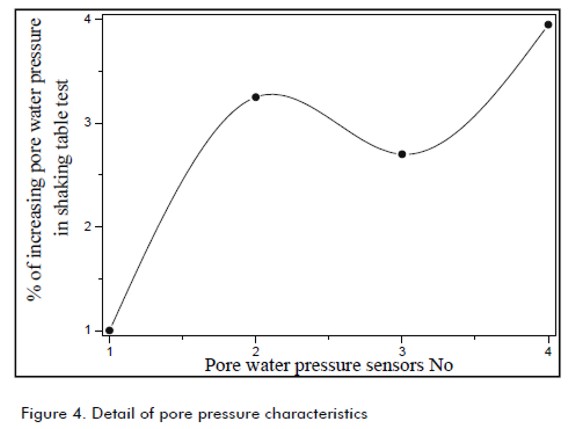
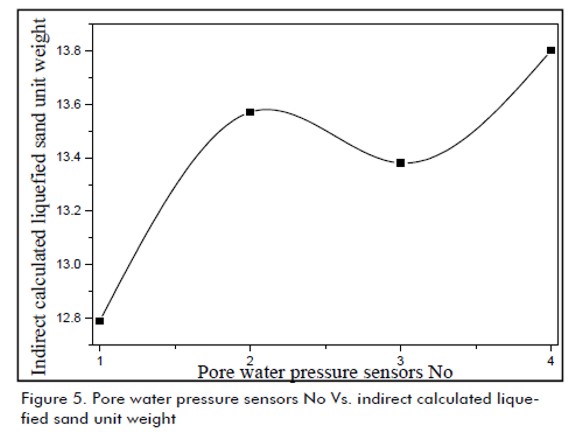

Conclusion
- The behaviour of the embankment model subjected to dynamic force has been studied and theoretical and experimental embankment seismic mitigation and pore water pressure functions evaluated;
- The pore water pressure result indicated nonlinear liquefaction governing system stability and the dense layer reducing nonlinear liquefaction and pore water pressure;
- The indirect simulation technique clearly indicated that stability and deformation could be precisely modelled and that earthen structures could be designed or redesigned based on that for optimising safety factors and achieving maximum stability and minimum project cost; and
- Theoretical and experimental embankment and subsoil pore water pressure analysis concluded that nonlinear liquefaction characteristics play a major role in the model´s behaviour.
Acknowledgements
The first author would like to thank the SJCE Civil Engineering faculty, Mysore, India, for its timely help and guidance.
References
Chang, M., Kuo, Ch-P., Shau, Sh-H., Hsu, R-E., Comparison of SPT-N-based analysis methods in evaluation of liquefaction potential during the 1999 Chi-chi earthquake in Taiwan., Computers and Geotechnics, 38, (3), 2011, pp. 393-406.
Chang, W. J., Evaluation of undrained shear strains in multidirectional horizontal shaking., Soil Dynamics and Earthquake Engineering, 31, (7), 2011, pp. 906-920
Chen, J., Shi. X., Li, J., Shaking table test of utility tunnel under non-uniform earthquake wave excitation., Soil Dynamics and Earthquake Engineering 30, (11), 2010, pp. 1400-1416.
Ha, I-K., Olson, S. M., Seo, M-W., Kim, M-M., Evaluation of reliquefaction resistance using shaking table tests., Soil Dynamics and Earthquake Engineering, 31, (4), 2011, pp. 682-691.
Heidari, T., Andrus, R. D., Mapping liquefaction potential of aged soil deposits in Mount Pleasant., South Carolina Engineering Geology, 112, (1), 2010, pp. 1-12
Hwang, J.H., Yang, C.W., Chen, C.H., Investigations on soil liquefaction during the Chi-Chi earthquake., Soils Found, 43 (6), 2003, pp. 107-123.
Ishihara, K., Yoshimine, M., Evaluation of settlements in sand deposits following liquefaction during earthquakes., Soils Found, 32 (1), 1992, pp. 173-188.
Jafarzadeh, F., Yanagisawa, E., Settlement of sand models under unidirectional shaking., In: Proceedings of the first international conference on earthquake and geotechnical engineering, IS-Tokyo´95, ( 2), 1995, pp. 693-8.
Kanatani, M., Nishi, K., Touma, J., Large shake table tests of saturated sand layer and numerical simulations by nonlinear analysis method., In: Proceedings of the first international conference on earthquake and geotechnical engineering, ISTokyo'95,(2), 1995, pp. 705-10.
Lee, K.Z.Z., Chang, N.Y., Ko, H.Y., Numerical simulation of geosynthetic-reinforced soil walls under seismic shaking., Geotextiles and Geomembranes, 28, (4), 2010, pp. 317-334.
Lee, Y-F., Chi, Y-Y., Juang, C. H., Lee, D-H., Annual probability and return period of soil liquefaction in Yuanlin., Taiwan attributed to Chelungpu Fault and Changhua Fault Engineering Geology, 114, (3-4), 2010, pp. 343-353.
Namdar A., Seismic Evaluation of Sandy Embankment Model., Bulletin of the Polytechnic Institute of Jassy, Universitatea Tehniâ, Gheorghe Asachi, din Iasi, Tomul LV (LIX), Fasc. 3, 2005, pp. 39-52.
Samui, P., Kim, D., Sitharam, T.G., Support vector machine for evaluating seismic-liquefaction potential using shear wave velocity., Journal of Applied Geophysics, 73, (1), 2011, pp. 8-15.
Shahir, H., Pak, A., Estimating liquefaction-induced settlement of shallow foundations by numerical approach., Computers and Geotechnics, 37, (3), 2010, pp. 267-279.
Tu, Y-H., Chuang, T-H., Liu, P-M., Yang, Y-S., Out-of-plane shaking table tests on unreinforced masonry panels in RC frames., Engineering Structures, 32, (12), 2010, pp 3925- 3935 .
Ueng, T.S., Wu, C.W., Cheng, H.W., Chen, C.H., Settlements of saturated clean sand deposits in shaking table tests., Soil Dynamics and Earthquake Engineering, 30, (2), 2010, pp. 50-60.
Van Laak, P.A., Taboada, V.M., Dobry, R., Elgamal, A.W., Earthquake centrifuge modeling using a laminar box., In: R.J. Ebelhar, V.P. Drnevich and B.L. Kutter, Editors, Dynamic geotechnical testing II, ASTM STP 1213, ASTM International, 1994, pp. 370-384.
Wei, Y-Ch., Lee , Ch-J., Hung, W-Y., Chen, H-T., Application of Hilbert-Huang transform to characterize soil liquefaction and quay wall seismic responses modeled in centrifuge shakingtable tests., Soil Dynamics and Earthquake Engineering, 30, (7), 2010, pp. 614-629.
Wang, Z., Lu, Y., Bai, Ch., Numerical simulation of explosioninduced soil liquefaction and its effect on surface structures., Finite Elements in Analysis and Design, 47, (9), 2011, pp. 1079-1090.
Yoshida, N., Finn, W.D.L., Simulation of liquefaction beneath an impermeable surface layer., Soil Dyn Earthquake Eng., 19 2000, pp. 333-338.
References
Chang, M., Kuo, Ch-P., Shau, Sh-H., Hsu, R-E., Comparison of SPT-N-based analysis methods in evaluation of liquefaction potential during the 1999 Chi-chi earthquake in Taiwan., Computers and Geotechnics, 38, (3), 2011, pp. 393-406. DOI: https://doi.org/10.1016/j.compgeo.2011.01.003
Chang, W. J., Evaluation of undrained shear strains in multidirectional horizontal shaking., Soil Dynamics and Earthquake Engineering, 31, (7), 2011, pp. 906-920 DOI: https://doi.org/10.1016/j.soildyn.2011.02.002
Chen, J., Shi. X., Li, J., Shaking table test of utility tunnel under non-uniform earthquake wave excitation., Soil Dynamics and Earthquake Engineering 30, (11), 2010, pp. 1400-1416. DOI: https://doi.org/10.1016/j.soildyn.2010.06.014
Ha, I-K., Olson, S. M., Seo, M-W., Kim, M-M., Evaluation of reliquefaction resistance using shaking table tests., Soil Dynamics and Earthquake Engineering, 31, (4), 2011, pp. 682-691. DOI: https://doi.org/10.1016/j.soildyn.2010.12.008
Heidari, T., Andrus, R. D., Mapping liquefaction potential of aged soil deposits in Mount Pleasant., South Carolina Engineering Geology, 112, (1), 2010, pp. 1-12 DOI: https://doi.org/10.1016/j.enggeo.2010.02.001
Hwang, J.H., Yang, C.W., Chen, C.H., Investigations on soil liquefaction during the Chi-Chi earthquake., Soils Found, 43 (6), 2003, pp. 107-123. DOI: https://doi.org/10.3208/sandf.43.6_107
Ishihara, K., Yoshimine, M., Evaluation of settlements in sand deposits following liquefaction during earthquakes., Soils Found, 32 (1), 1992, pp. 173-188. DOI: https://doi.org/10.3208/sandf1972.32.173
Jafarzadeh, F., Yanagisawa, E., Settlement of sand models under unidirectional shaking., In: Proceedings of the first international conference on earthquake and geotechnical engineering, IS-Tokyo ‘95, (2), 1995, pp. 693-8.
Kanatani, M., Nishi, K., Touma, J., Large shake table tests of saturated sand layer and numerical simulations by nonlinear analysis method., In: Proceedings of the first international conference on earthquake and geotechnical engineering, IS-Tokyo'95, (2), 1995, pp. 705-10.
Lee, K.Z.Z., Chang, N.Y., Ko, H.Y., Numerical simulation of geosynthetic-reinforced soil walls under seismic shaking., Geotextiles and Geomembranes, 28, (4), 2010, pp. 317-334. DOI: https://doi.org/10.1016/j.geotexmem.2009.09.008
Lee, Y-F., Chi, Y-Y., Juang, C. H., Lee, D-H., Annual probability and return period of soil liquefaction in Yuanlin., Taiwan attributed to Chelungpu Fault and Changhua Fault Engineering Geology, 114, (3-4), 2010, pp. 343-353. DOI: https://doi.org/10.1016/j.enggeo.2010.05.012
Namdar A., Seismic Evaluation of Sandy Embankment Model., Bulletin of the Polytechnic Institute of Jassy, Universitatea Tehnică, Gheorghe Asachi, din Iasi, Tomul LV (LIX), Fasc. 3, 2005, pp. 39-52.
Samui, P., Kim, D., Sitharam, T.G., Support vector machine for evaluating seismic-liquefaction potential using shear wave velocity., Journal of Applied Geophysics, 73, (1), 2011, pp. 8-15. DOI: https://doi.org/10.1016/j.jappgeo.2010.10.005
Shahir, H., Pak, A., Estimating liquefaction-induced settlement of shallow foundations by numerical approach., Computers and Geotechnics, 37, (3), 2010, pp. 267-279. DOI: https://doi.org/10.1016/j.compgeo.2009.10.001
Tu, Y-H., Chuang, T-H., Liu, P-M., Yang, Y-S., Out-of-plane shaking table tests on unreinforced masonry panels in RC frames., Engineering Structures, 32, (12), 2010, pp 3925- 3935. DOI: https://doi.org/10.1016/j.engstruct.2010.08.030
Ueng, T.S., Wu, C.W., Cheng, H.W., Chen, C.H., Settlements of saturated clean sand deposits in shaking table tests., Soil Dynamics and Earthquake Engineering, 30, (2), 2010, pp. 50-60. DOI: https://doi.org/10.1016/j.soildyn.2009.09.006
Van Laak, P.A., Taboada, V.M., Dobry, R., Elgamal, A.W., Earthquake centrifuge modeling using a laminar box., In: R.J. Ebelhar, V.P. Drnevich and B.L. Kutter, Editors, Dynamic geotechnical testing II, ASTM STP 1213, ASTM International, 1994, pp. 370-384. DOI: https://doi.org/10.1520/STP13225S
Wei, Y-Ch., Lee, Ch-J., Hung, W-Y., Chen, H-T., Application of Hilbert-Huang transform to characterize soil liquefaction and quay wall seismic responses modeled in centrifuge shaking-table tests., Soil Dynamics and Earthquake Engineering, 30, (7), 2010, pp. 614-629. DOI: https://doi.org/10.1016/j.soildyn.2010.02.005
Wang, Z., Lu, Y., Bai, Ch., Numerical simulation of explosion-induced soil liquefaction and its effect on surface structures., Finite Elements in Analysis and Design, 47, (9), 2011, pp. 1079-1090. DOI: https://doi.org/10.1016/j.finel.2011.04.001
Yoshida, N., Finn, W.D.L., Simulation of liquefaction beneath an impermeable surface layer., Soil Dyn Earthquake Eng., 19 2000, pp. 333-338. DOI: https://doi.org/10.1016/S0267-7261(00)00018-X
How to Cite
APA
ACM
ACS
ABNT
Chicago
Harvard
IEEE
MLA
Turabian
Vancouver
Download Citation
CrossRef Cited-by
1. Abdoullah Namdar, Yun Dong, Yuyi Liu. (2019). The effect of nonlinearity of acceleration histories to timber beam seismic response. Material Design & Processing Communications, 1(2), p.e53. https://doi.org/10.1002/mdp2.53.
2. Amin Gholam-Abbas Shotorbani, Nader Shariatmadari, Mehran Karimpour-Fard, Abdoullah Namdar, B. P. Naveen, Mohammad Aghaei Asl. (2023). Influence of polyurethane in the polymerization process for poorly graded sand stabilization and cementing. Arabian Journal of Geosciences, 16(6) https://doi.org/10.1007/s12517-023-11465-3.
3. Abdoullah Namdar. (2020). The strain energy development on subsoil-embankment because of seismic wave direction. IOP Conference Series: Earth and Environmental Science, 442(1), p.012015. https://doi.org/10.1088/1755-1315/442/1/012015.
4. Abdoullah Namdar, Omer Mughieda, Yuyi Liu, Yin Deyu, Yun Dong, Yadong Chen. (2024). Prediction of the Single Pile Seismic Deflection by Using FEM and ANN. Geotechnical and Geological Engineering, 42(3), p.2025. https://doi.org/10.1007/s10706-023-02659-3.
5. Omer Mughieda, Abdoullah Namdar, Marwan Alzaylaie, Abdul Syukor Abd.Razak, Pavlo Maruschak. (2025). The Effect of Preexisting Fracture Angles on Crack Propagation in Sandstone. Material Design & Processing Communication, 2025(1) https://doi.org/10.1155/mdp2/4664900.
6. Abdoullah Namdar. (2020). Prediction of the settlement of a pile and assessment seismic soil-pile interaction - An analytical investigation. Procedia Structural Integrity, 28, p.311. https://doi.org/10.1016/j.prostr.2020.10.037.
7. A Namdar. (2019). The concrete footing-soil foundation seismic interaction, strain energy and stress mechanism. IOP Conference Series: Earth and Environmental Science, 289(1), p.012009. https://doi.org/10.1088/1755-1315/289/1/012009.
8. Lijie Guo, Wenchen Li, Abdoullah Namdar. (2021). Using recycled aggregate for seismically monitoring of embankment-subsoil model. Case Studies in Construction Materials, 15, p.e00605. https://doi.org/10.1016/j.cscm.2021.e00605.
9. Abdoullah Namdar. (2021). The boundary condition simulation quality for embankment seismic response. Engineering Failure Analysis, 126, p.105491. https://doi.org/10.1016/j.engfailanal.2021.105491.
10. Abdoullah Namdar. (2021). Design geometry of the embankment for minimize nonlinear displacement. Material Design & Processing Communications, 3(5) https://doi.org/10.1002/mdp2.209.
11. Abdoullah Namdar. (2021). Characterization and Prediction of Nonlinear Stress-Strain Relation of Geostructures for Seismic Monitoring. Structural Durability & Health Monitoring, 15(2), p.167. https://doi.org/10.32604/sdhm.2021.011127.
Dimensions
PlumX
Article abstract page views
Downloads
License
Copyright (c) 2011 Abdoullah Namda, Azam Khodashenas Pelko

This work is licensed under a Creative Commons Attribution 4.0 International License.
The authors or holders of the copyright for each article hereby confer exclusive, limited and free authorization on the Universidad Nacional de Colombia's journal Ingeniería e Investigación concerning the aforementioned article which, once it has been evaluated and approved, will be submitted for publication, in line with the following items:
1. The version which has been corrected according to the evaluators' suggestions will be remitted and it will be made clear whether the aforementioned article is an unedited document regarding which the rights to be authorized are held and total responsibility will be assumed by the authors for the content of the work being submitted to Ingeniería e Investigación, the Universidad Nacional de Colombia and third-parties;
2. The authorization conferred on the journal will come into force from the date on which it is included in the respective volume and issue of Ingeniería e Investigación in the Open Journal Systems and on the journal's main page (https://revistas.unal.edu.co/index.php/ingeinv), as well as in different databases and indices in which the publication is indexed;
3. The authors authorize the Universidad Nacional de Colombia's journal Ingeniería e Investigación to publish the document in whatever required format (printed, digital, electronic or whatsoever known or yet to be discovered form) and authorize Ingeniería e Investigación to include the work in any indices and/or search engines deemed necessary for promoting its diffusion;
4. The authors accept that such authorization is given free of charge and they, therefore, waive any right to receive remuneration from the publication, distribution, public communication and any use whatsoever referred to in the terms of this authorization.



